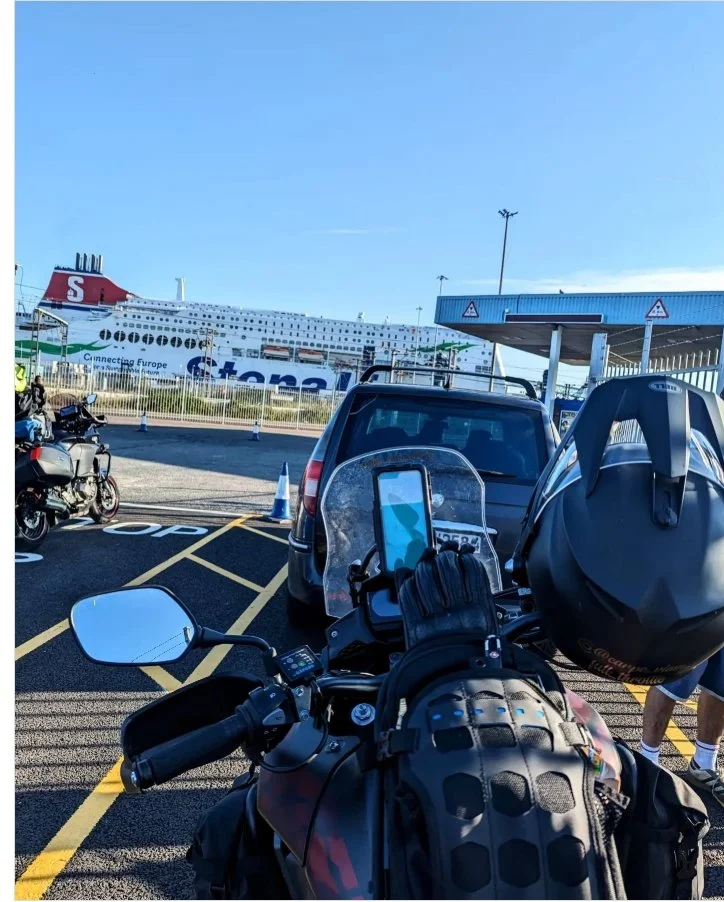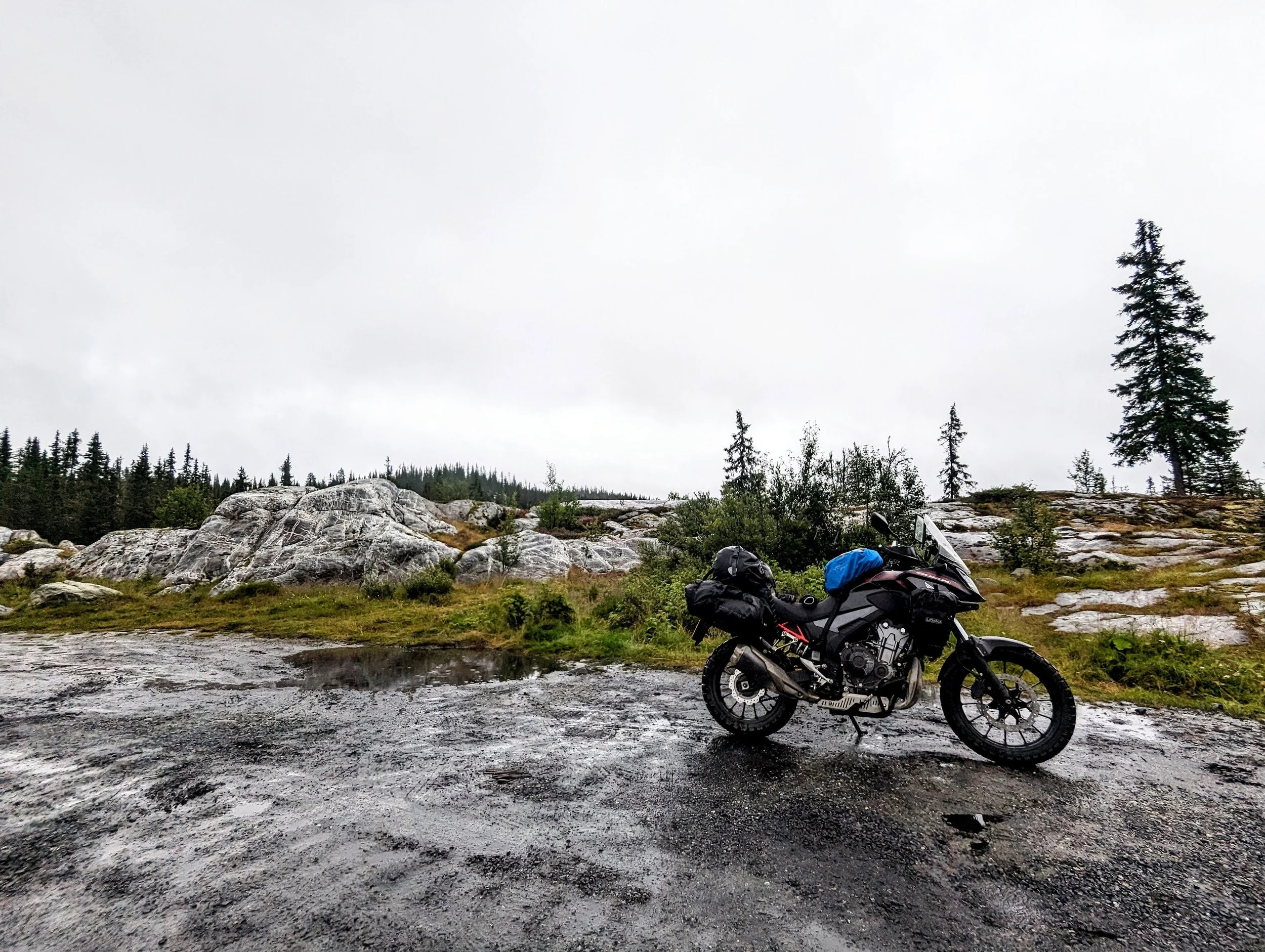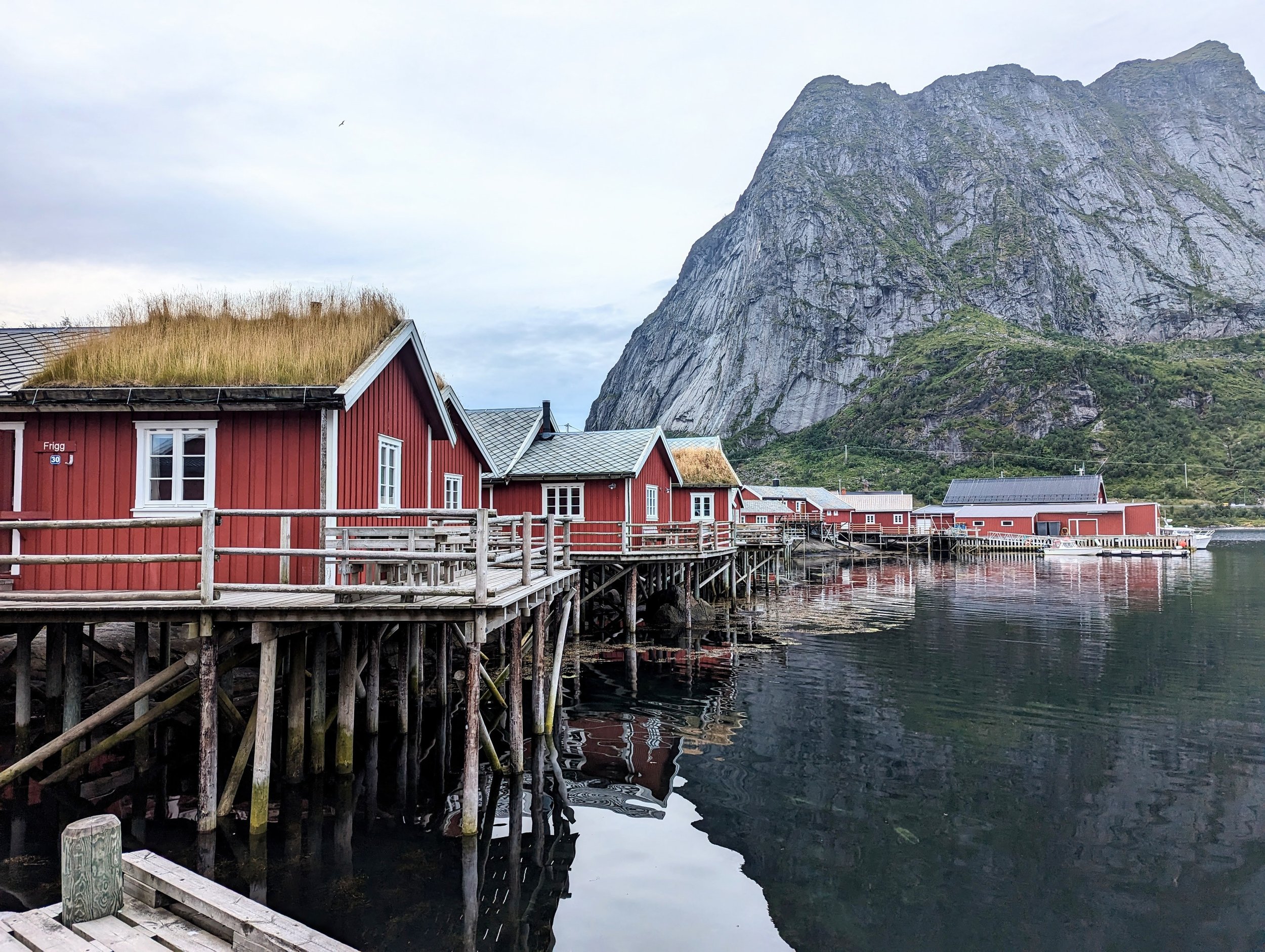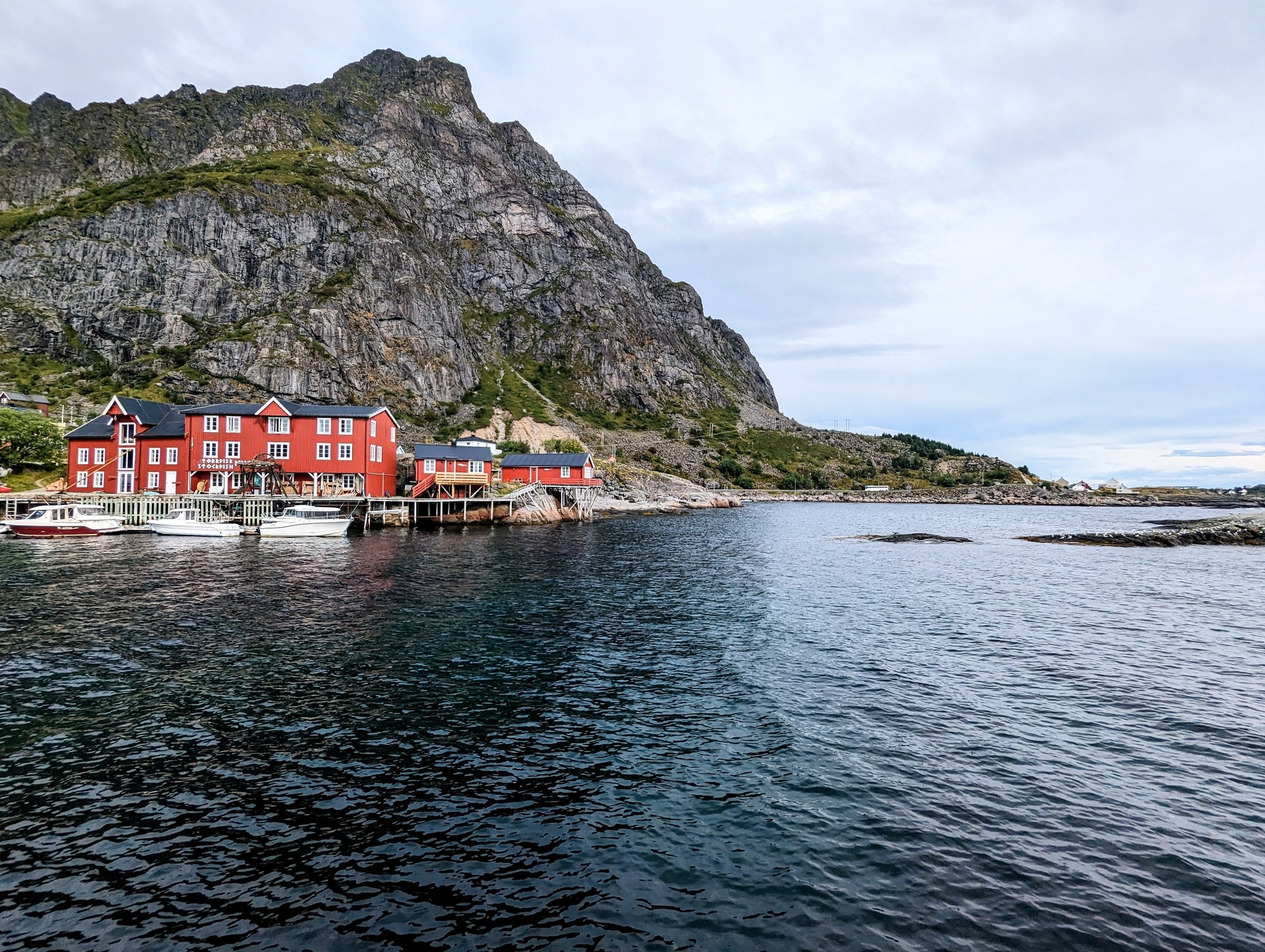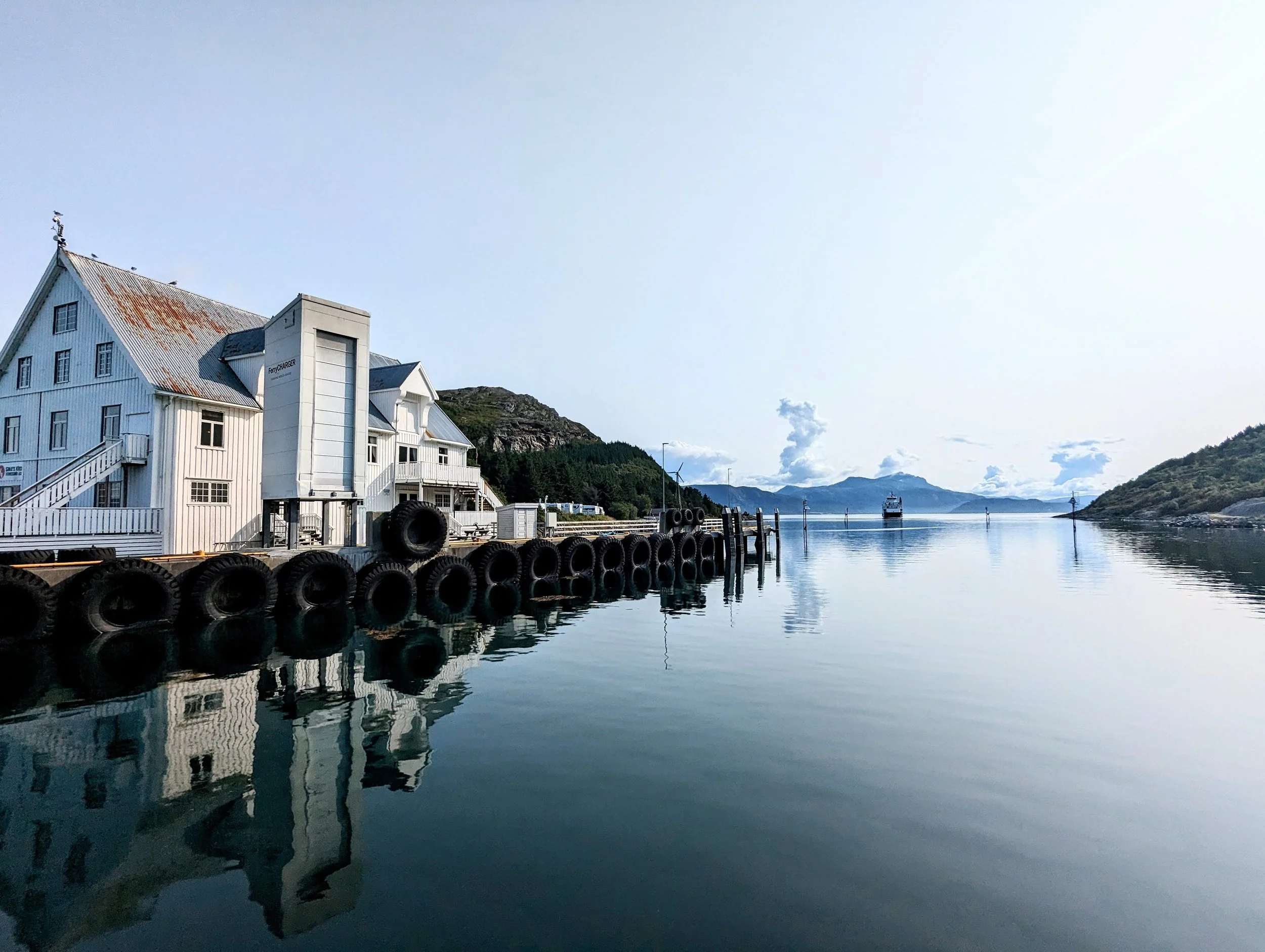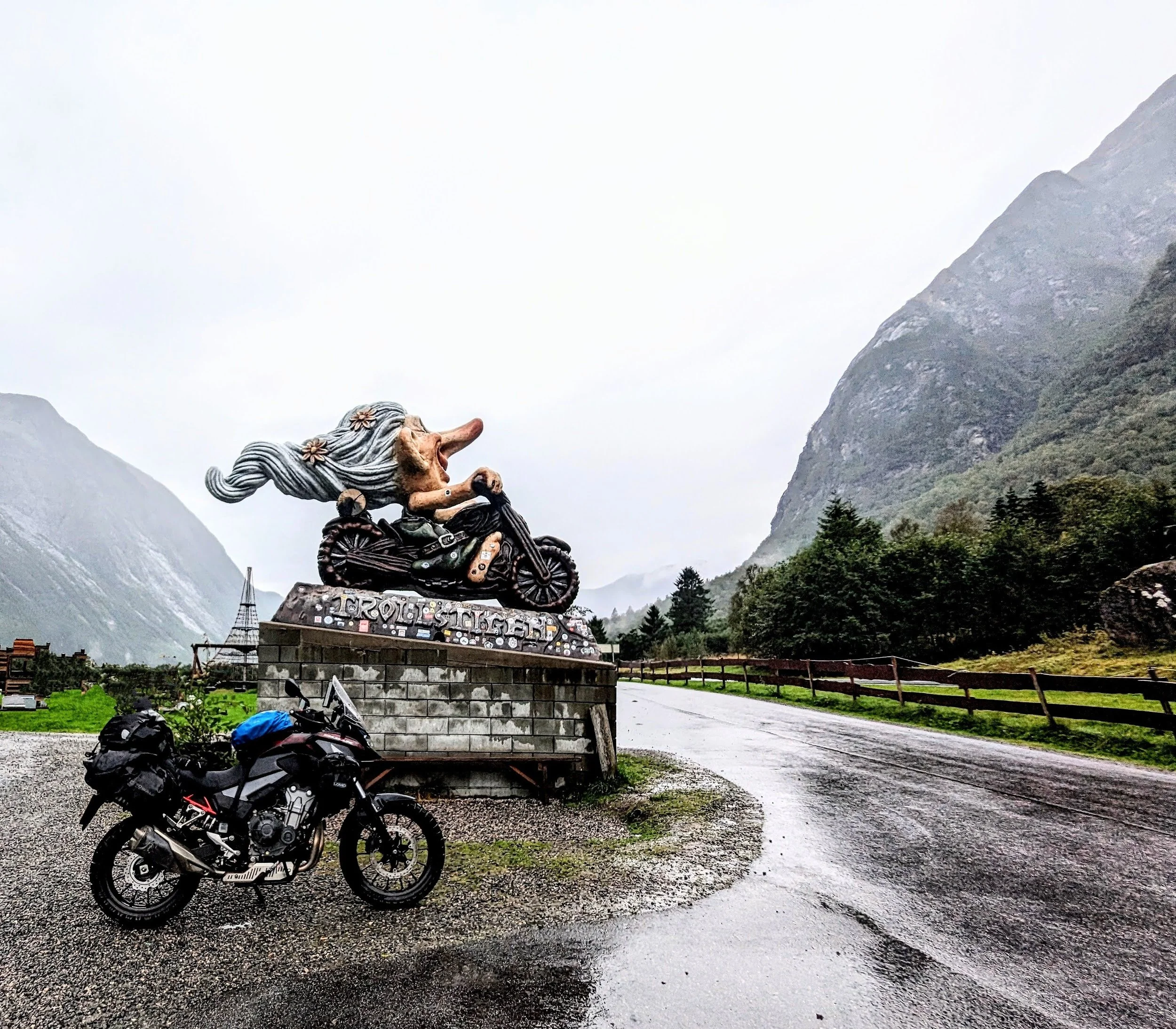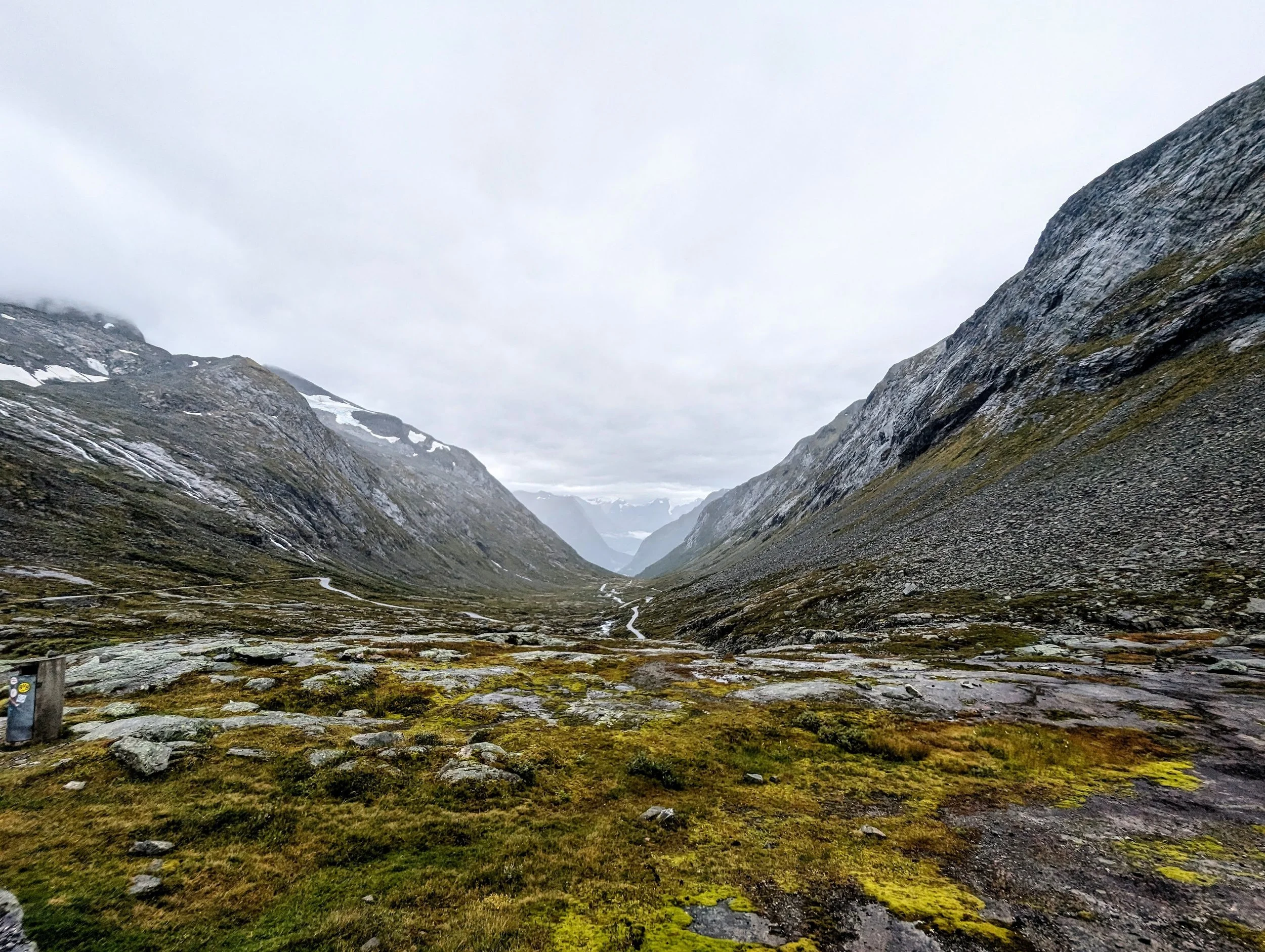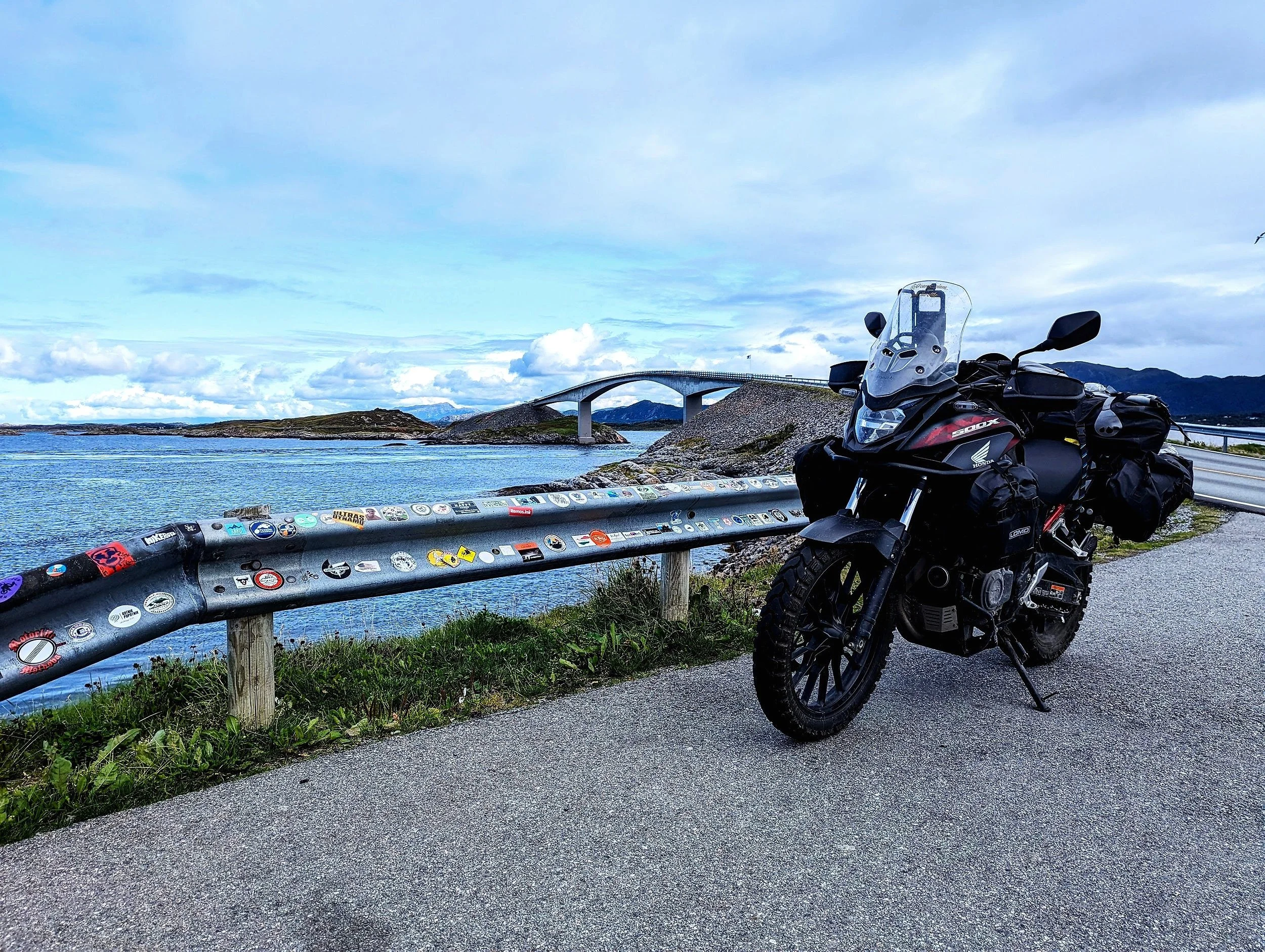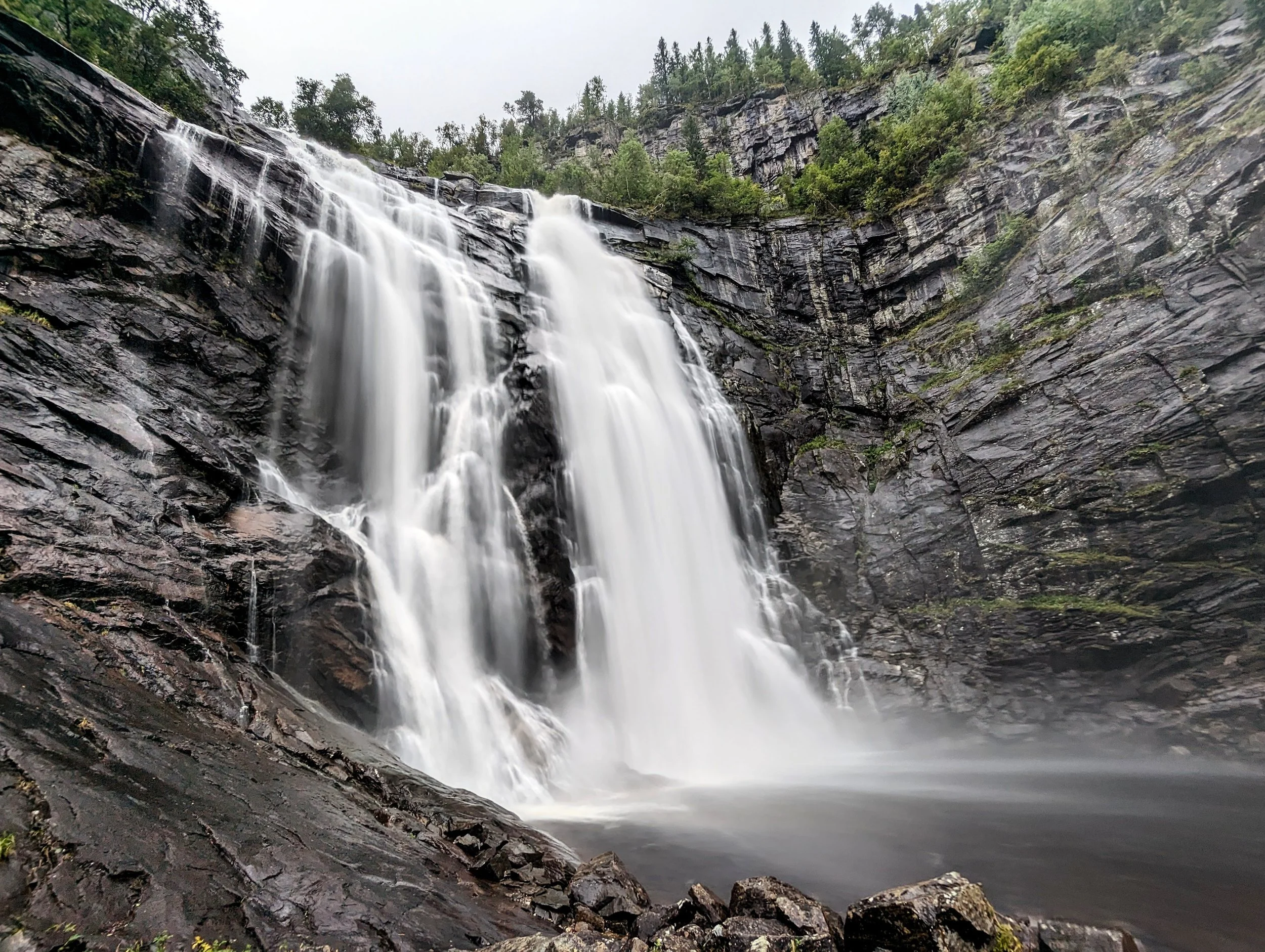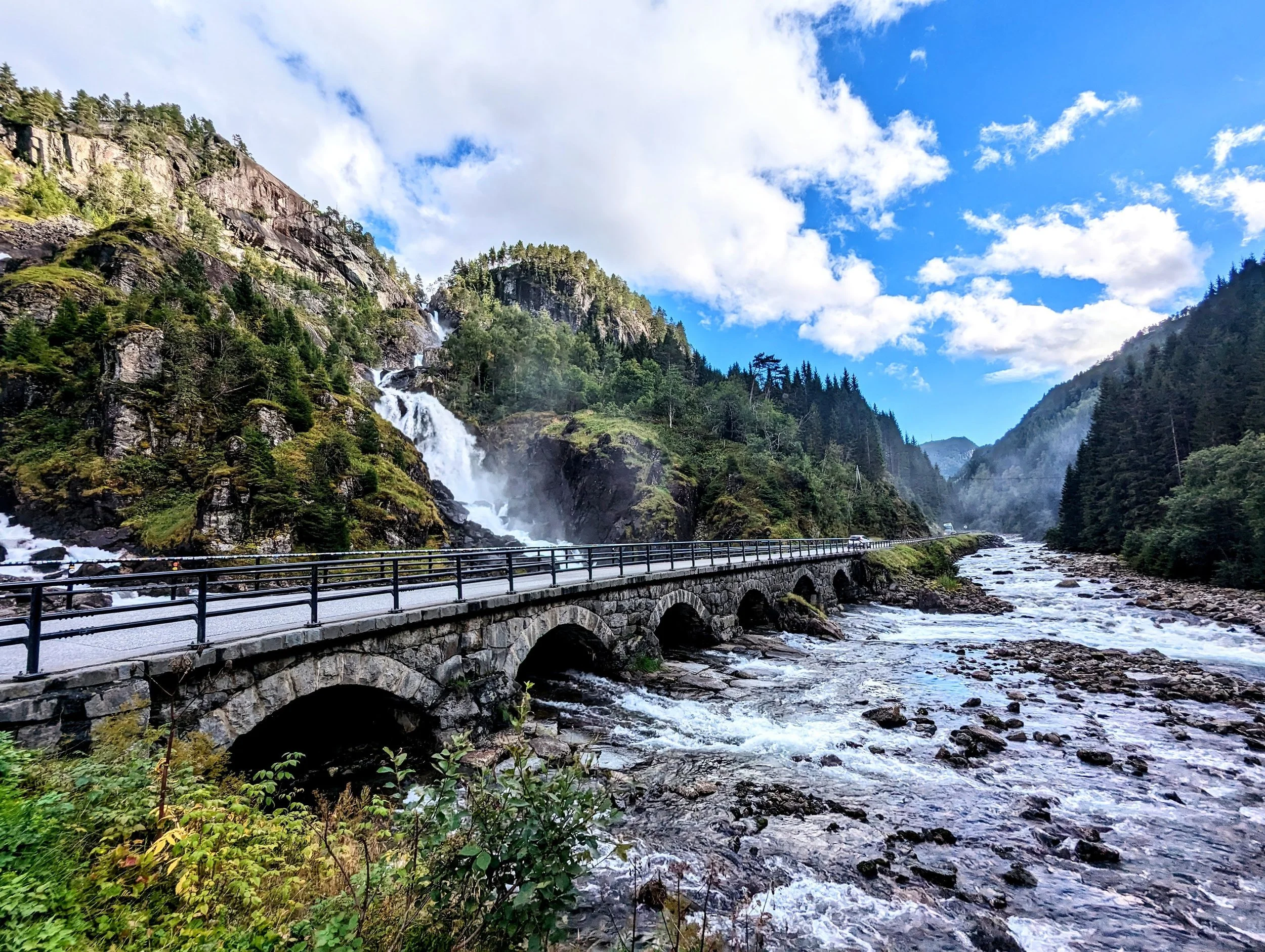The Arctic CIrcle Ultimate Motorcycle Itinerary
Chasing the Arctic sun, one epic mile at a time — your ultimate northern adventure starts here.
Riding into the Arctic Circle is one of those trips that lingers with you long after the tyres cool. From endless roads winding through Norway’s raw, dramatic landscapes to quiet fishing villages and remote mountain passes, this route is about so much more than just reaching the top—it's about everything in between.
This ultimate Arctic Circle itinerary is designed to take around 28 days, but it’s totally flexible depending on your timeframe. Whether you’ve got two weeks or two months, you can adapt it to suit your ride style. Want to keep it smooth and fast? Stick to tarmac and carve your way up the coast on some of Europe’s most scenic highways. Craving something wilder? Include stretches of the Trans Euro Trail for a proper backcountry experience with gravel, solitude, and stories you’ll be telling for years.
The best time to go? August to September. By then, the peak tourist traffic has faded, but you’ll still catch the midnight sun hovering on the horizon, especially the further north you go. The weather is relatively stable, the campsites are quieter, and the roads are yours for the taking.
This is your invitation to ride past the Arctic Circle sign and keep going—into fjords, over glaciers, through valleys, and across landscapes where the light never seems to end. This guide will take you through everything you shouldn’t miss, from iconic roads and wild camping spots to the little fishing villages that make you want to stay forever.
Interested in my detailed itinerary? Stay tuned for a downloadable guide that takes out all the pain of planning this amazing adventure—leaving you free to just gear up, start your engine, and ride.
Getting Started: Ride, Ship, or Rent
Planning your start depends on where you’re coming from:
From the UK: Many riders choose to take the ferry from Harwich or Newcastle to the Netherlands or northern Germany, then begin the journey from there (e.g., Bremen). This allows you to ride your own bike and travel with full gear from home.
From Europe: Starting from Germany, the Netherlands, or Denmark offers easy overland access into Sweden or Norway. Consider beginning in Bremen, Hamburg, or Copenhagen for convenience and great road connections.
Flying In & Renting a Motorcycle: If you're short on time or don't want to ship your bike, flying in and renting is a great option. Here are trusted rental providers in key locations:
Denmark:
MC Rentals Copenhagen – mc-rent.dk
MotoBikeRent Denmark (Copenhagen & Aalborg)
Sweden:
Motorcykeluthyrning i Stockholm – Great for exploring the Swedish TET.
Northbike Umeå & Sundsvall – Offers touring and adventure bikes.
Norway:
Renten MC – Oslo – rentenmc.no
EagleRider Norway – Offers GS models for long-distance touring.
Bikerental Norway (Bergen) – Great option if starting near the fjords.
Make sure to book your rental well in advance, especially during summer months. Most providers include panniers, GPS, and gear rental options. Licensing and insurance requirements vary, so double-check that you're compliant for riding in Scandinavia.
The Not so Fun Stuff - paperwork & Essenstials
Before hitting the road, make sure you’ve got all the right documents and gear in place. Here’s a checklist to keep your ride smooth and stress-free:
Required Documents:
Valid Passport (with at least 6 months remaining)
Motorcycle License (Full A license for rentals)
International Driving Permit (if applicable)
Motorcycle Registration Documents (V5C or equivalent)
Proof of Insurance (check if your policy covers Europe/Scandinavia)
Green Card (optional but recommended for proof of insurance in Europe)
Essential Items to Pack:
European Health Insurance Card (EHIC) or GHIC (UK residents)
High-visibility vest & warning triangle (legal in some countries)
First aid kit
Spare bulbs and fuses
Paper map or offline GPS backup
Fobs & Toll Passes:
Norwegian Toll Roads: Many bridges and private tunnels require payment. Consider registering with AutoPASS before your trip to save you time, hassle and a bit of money. If you register they send you a fob you can attach to your bike that takes automatic payment. For more details and to register Click Here.
Ferry Reservations: Book in advance for routes like Gryllefjord → Andenes or Kristiansand → Hirtshals.
Private Roads: In remote areas, some private toll roads or seasonal mountain passes may be cash-only or require local app access (like EasyPark or Vipps in Norway).
Tip: Always carry a small stash of local currency for unmanned toll booths or rural ferry crossings.
Where to Stay
In Norway, Sweden and Finland recognizes “the right to roam” making wild camping legal and a fantastic way to tour Scandinavia. There are also many structures that you can stay in the cater to people wild camping in the wilderness. Some are only reachable by hiking but many are also accessible by two wheels (or more).
Wild Camping
Rules & Considerations to Abide By:
Distance from Buildings: You must stay at least 150 meters away from any inhabited house or cabin.
No Damage or Disturbance: Avoid damaging the environment or disturbing others.
No Farmland: Avoid private properties, meadows, pastures, gardens, and agricultural land.
Limited Stay: You can stay in one place for up to two nights without permission.
Fire Restrictions: Campfires are prohibited from April 15th to September 15th.
Respect Nature: Pick up your trash and leave the area as clean as you found it.
No Harassment: Don't disturb animals or nature.
Wild Food: You may pick wild berries, mushrooms, and wildflowers for your own consumption, but be cautious about edible and inedible varieties.
Fishing: Fishing for saltwater fish is generally allowed without a license, but you'll need a license for freshwater fishing.
Longer Stays: If you plan to stay for more than two nights in the same location, you should ask for the landowner's permission.
Helpful Apps and websites to find spots ahead of time:
iOverlander - download for Apple/Android
CampWild - website
Bunk-a-Biker
Bunk-a-Biker is a worldwide community of motorcycle riders who offer to host traveling riders at their homes for free. The idea isn't for a free place to stay, it's for building and promoting an uplifting, positive, and supportive community where you can meet your fellow bikers. I’ve used this many times and it’s a great way to meet and support fellow bikers and adventurers. Click Here for the website. Unlike Couch-Surging there isn’t a rating system for hosts and travelers. So get to know who you are staying with prior to agreeing to stay.
Couch-Surfing
Couch Surfing is a community of people who offer to host travellers whether it’s in a spare room, sofa, etc. There is a rating system for both the host and the traveler so people can assess who they might be staying with. A great safety option. I’ve met some fantastic people and familes using this app. Many of which who have been happy to show me around and see the less touristy areas of where I’m staying. Click Here
What to Pack
Camping
- Sleeping Bag
- Sleeping Bag Liner (for extra warmth)
- Pillow
- Tent
- Air mattress
- Torch
- Stove
- Cooking Equipment
- Knife
- Aeropress (if you can't live without coffee like me)
- Towel
- Sheet
- Chair
- Paracord
Bike/Luggage
- Waterproof soft panniers
- Waterproof Rollbag
- Tankbag
- Crash bar panniers
- Toolroll
- Fuel Canisters
- Extra Water
- Side stand puck
- Air-pump
- Waterproof bag
- Electronics Bag
- Packing cubes
- Rok Straps
- Hydration bladder pack
- Sat/Nav/Phone/Paper Maps
- Spare old phone (in case your main one gets damaged)
- Emergency food/snacks
- First Aid Kit
- Disc Lock
- Owner’s Manual (downloaded and easily accessible)
Clothing
- Light packable down jacket
- Thermals
- Trousers
- Shorts
- T-shirts
- Underwear
- Flip-flops
- Light walking shoes
- Socks
- Swimwear
- Merino wool sweater or fleece sweater
Hygiene
- Toothbrush and toothpaste (I use the toothpaste tablets from Lush — easy to pack, no squished tubes)
- Shampoo/body wash/face wash (I use Lush products — compact, travel-friendly, and lake/river safe)
- Deodorant
- Shaving kit
- Hand sanitiser
- Mosquito repellent
- Sunscreen
- Lip balm
- Moisturiser
- Laundry detergent sheets
The Route
Day 1 -10: Trans European Trail
Officially starting my journey from Copenhagen, I crossed the Oresundsbron Bridge into Sweden joining the Sweden Trans European Trail (TET). I took the TET in Sweden to the Norwegian border just north of Oslo at which point I hopped onto the Norwegian TET for an almost circular route before heading back into Sweden. I continued on the Sweden TET with a couple diversions specifically for Flatruet. The highest road in Sweden. The route options for the Sweden TET have grown considerably since I travelled there so there are many routes to try for your own adventure. I will say that the Sweden TET does very much become very same-same landscape wise to the point where I ended up pushing through and hitting the tarmac to join back onto the last bit of the Norway TET in the arctic circle. I find that in comparison the Norwegian TET landscape changes very dramatically very quickly so once having a small taste you want to go back. To download the TET routes check out their website. It’s every growing and constantly being updated.
Sweden start after crossing the bridge in Copenhagen.
Crossing into Norway just north of Oslo for the Norway TET.
Joining back onto the Sweden TET to continue North.
The last portion of the Norwegian TET to Nordkapp.
Must Not Miss
Jotunheimen National Park
What: A beautiful scenic road glides through this National Park that easily adds onto the Norwegian TET
Where: Fv51, 2953 Beitostølen, Norway (61.9204, 9.3385)
Notes: The weather is very temperamental. Even in the middle of summer so be prepared. Make sure you save sometime to just enjoy the area. I felt like I rode through to quickly and I need to return.
Blåhø Mountain
What: A mountain located enroute of the Norway TET. The road up is beautiful scenery. Don’t miss it!
Where: Unnamed Road, 2663, Vågå kommune, Norway
Notes: This route is amazing. The scenery changes drastically very quickly as you ascend the mountain. Unfortunately I arrived in Norway just after a storm so due to roads being washed out I had to take multiple detours instead of following the trail directly. Fortunately in Norway it’s very easy to find some dirt tracks to keep you entertained.
Rondane National Park
What: Is the oldest national park in Norway located in the Innlandet county. It contains ten peaks over 2,000 metres and is an important habitat for herds of wild reindeer.
Where: Innlandet County, Norway
Notes: Wonderful area to wild camp, hike and ride around.
Grimsdalen Valley
What: What locals consider to be the most beautiful vallei’s in Norway. Truly, the views are spectacular!
Where: Hedmark County, Norway
Notes: Beautiful spot to wild camp.
Flatruet
What: Considered to be the higheset public road in Sweden. Ascending to a mountain plateau at an elevation of 964m.
Where: Jamtland County, Sweden
Notes: A gravel track road that could easily be done on a road bike. Be wary of reindeer, this seems to be a hotspot for them as they are constantly darting across the road. This landscape was very different compared to the rest of my tour but worth a small detour off the TET if you have the time.
Nordkapp 71º 10' 21" -
What: Northern most point in Europe that can be accessed by car.
Where: Northern Coast of the island of Magerøya , 71°10′21″N 25°47′04″E
Notes: A visit to Nordkapp comes with an entrance fee to access the visitor centre and monument, which has extended hours during certain seasons to let tourists catch the midnight sun. On some nights, it stays open as late as midnight.
If you're riding a motorcycle, the best time to visit might actually be after hours. I set up camp near the start of the Knivskjellodden Trail, just 5.5 km down the road, then rode up to the globe at 3 AM skirting around the barriers. No crowds, no queues—just me, the open sky, and sweeping views at the top of Europe. All night long, you could hear the distant hum of other bikes echoing along the cliffs as riders did the same.
Nordkapp Pitch Spot: Knivskjelodden Trail parking, Knivskjelodden Trail, 9764 Nordkapp, Norway
Day 11 - 18: Lofoten Islands
Leaving Nordkapp, you can meander your way down the west coast of Norway. The roads are perfect passing through mountains passes and along fjords. Once you arrive in the Lofoten’s you can take your time to explore the islands. There are tons of coastal roads to ride and just relax and enjoy the views. If you want to stretch your legs there are plentiful of hikes to explore. Grab a kayak and explore the waters or just enjoy the many beaches. Be sure to try the traditional snack of tørrfisk, dried fish from the Lofoten which is wild caught skrei (cod) from the sea or enjoy a kanelboller (cinnamon bun) at one of the many cafe’s in town. They use the same process of long natural drying and maturation as the Vikings did 1000 years ago and can be found in any shop. Don’t forget to stop by in the famous towns Reine and Å , to see the famous traditional rorbuer settled over the water set against the mountains and sea. I used my time here to reset, breathe and have a bit of down time. Taking in the beauty and meandering around, and enjoying the bridges that connect this scatter of islands together.
Must Not Miss
Foldvik
What: One of the most photographed fishing villages in Norway—and it’s easy to see why.
Where: Located along the Varangerfjord in Eastern Finnmark, not far from the Russian border, Foldvik is tucked between the Barents Sea and rugged Arctic.
Notes: It’s a quiet, lesser-visited gem, making it perfect for riders looking to escape the crowds. There's a small harbour, a beautiful coastal road in and out of town, and sweeping views across the fjord. With plenty of spots to wild camp within walking distance to this little village why wouldn’t you stop here.
Hamnøy
What: One of the most photographed fishing villages in all of Norway—and once you arrive, you’ll instantly see why.
Where: Located on the island of Moskenesøya in the Lofoten archipelago, just east of Reine, Hamnøy sits along the E10 scenic route and is part of the stunning chain of villages connected by bridges and fjords.
Notes: Hamnøy is a picture-perfect village with iconic red rorbuer over the water and dramatic mountain backdrops—especially stunning at sunrise and sunset. Staying in a waterfront cabin offers a peaceful, unforgettable experience. It’s a must-stop for riders and photographers alike, with easy access to nearby Reine and hikes like Reinebringen. Ideal for catching the northern lights in the right season.
Sakrisøy
What: A tiny fishing village known for its bright yellow rorbuer cabins, turquoise waters, and epic mountain views.
Where: Nestled between Reine and Hamnøy on the E10 in the Lofoten Islands, Sakrisøy sits right along the main scenic route through Moskenesøya.
Notes: Sakrisøy is a perfect stop for a scenic break and a bite to eat. The village offers stunning views and a unique splash of color with its iconic yellow rorbuer. Be sure to grab lunch at Anitas Sjømat, a local favourite known for fresh seafood snacks, fish burgers, and tørrfisk. A laid-back spot with one of the best backdrops in Lofoten.
Henningsvar
What: Known as the “Venice of Lofoten” for its layout on small islands with charming bridges.
Where: Located on the southern coast of Austvågøya in the Lofoten Islands, Henningsvær is just a short detour off the E10 and well worth the ride.
Notes: Henningsvær blends scenic beauty with a creative, laid-back atmosphere. You’ll find art galleries, cozy bakeries, excellent restaurants, and unique local shops with handcrafted goods. It’s also home to the iconic Henningsvær Stadium, perched dramatically on the rocks by the sea. If I wasn’t on the bike, I probably would’ve gone home with half a shop’s worth of handmade items—definitely a must-see if you enjoy that kind of vibe.
Nusford
What: A UNESCO-recognized historic fishing village, preserved like a living museum.
Where: Located on Flakstadøya in the Lofoten Islands, Nusfjord is a short detour off the E10, tucked into a sheltered fjord and surrounded by steep cliffs.
Notes: Nusfjord offers an immersive step back in time, showcasing what 19th-century fishing life was like in the Arctic. It’s quiet, charming, and full of atmosphere. Head there early, grab a coffee, and take a slow wander through the old wooden buildings, docks, and boat sheds. The village also has cozy lodging options if you’re looking to stay the night. Perfect for a peaceful break from the road.
Reine
What: A small fishing village located on the island.
Where: Moskenes Municipality, Lofoten Islands, Arctic Norway
Notes: Iconic red rorbuer cabins and dramatic fjord views. Picture perfect and a lovely place for a walk, hike or kayak.
Å (yes, just Å)
What: The last village on the E10 road and one of Norway’s best preserved fishing villages.
Where: Located in Moskenes Municipality, Lofoten Islands, Arctic Norway—right at the southern tip of the E10 scenic route.
Notes: Å is postcard-perfect, with iconic red rorbuer, dramatic fjord views, and a peaceful, end-of-the-road charm. It’s ideal for a slow wander through the village, a short hike in the surrounding hills, or a quiet paddle in the clear Arctic waters. The atmosphere is cinematic and calm—well worth the ride to the very tip of Lofoten. It also makes a perfect final stop before catching the ferry to Bodø from the nearby port village of Moskenes.
Day 19-27
Leaving the Lofoten Islands and taking the ferry to Bodo. You start heading south. Leaving the Arctic Circle and seeking more incredible fjords and mountains. Weaving your way through an endless amount of national parks while hugging the western coastline. Taking ferry after ferry, which seems to be a normal way to meander your way through this part of Norway and crossing some spectacular bridges including the ever famous Atlantic Road. Eventually you start heading further inland as you can’t miss the famous Trolldestien Pass filled with terrifying switch backs and finishing with one of the most amazing viewpoints. Followed by the Gamle Strynefjellsvegen, otherwise known as the wilderness road. Though the one thing you’ll miss is the quiet of the arctic circle as you quickly start entering one of the tourist hotspots. Roads are a bit busier and a few of the stops are worth visiting first thing in the morning and last thing in the evening to avoid the crowds.
Must Not MIss
Arctic Circle Centre Norway
What: A landmark visitor centre marking the exact point where the E6 highway crosses the Arctic Circle—complete with exhibits, souvenirs, and a chance to officially “cross” into the Arctic.
Where: Located on the E6 highway at Saltfjellet, Nordland County, Norway — approximately halfway between Mo i Rana and Fauske.
Notes: The Arctic Circle Centre is a fun and symbolic stop for riders heading north. Surrounded by a stark, highland landscape, it offers a café, gift shop, and exhibits on Arctic wildlife and polar exploration. There’s a large parking area and a photo-op spot marking the Arctic Circle line. A great place to stretch your legs, grab a coffee, and take in the fact that you're officially riding into the Arctic.
Helgeland Bridge
What: A striking cable-stayed bridge that spans the Leirfjorden, known for its sleek architecture and stunning natural surroundings. It’s one of the longest bridges in Norway and a highlight along the scenic Kystriksveien (Coastal Route 17).
Where: Located near the town of Sandnessjøen in Nordland County, Northern Norway. The bridge connects the mainland to the island of Alsta, home to the iconic Seven Sisters mountain range.
Notes: A scenic landmark along the Kystriksveien route with stunning views of fjords and mountains. Great photo spot, especially at sunrise or sunset. Near Sandnessjøen and the Seven Sisters mountains—ideal for a riding break or hike.
Atlantic Ocean Road
What: One of the most iconic coastal drives in the world, the Atlantic Ocean Road is a rollercoaster-like stretch of highway that hops across several small islands via sweeping bridges and causeways.
Where: Located in Møre og Romsdal County, Western Norway. The road runs between the towns of Kristiansund and Molde, primarily along County Road 64.
Notes: Famous for its dramatic design and wild ocean views, especially during stormy weather. The ride offers thrilling curves, scenic pull-offs, and picture-perfect bridges—particularly the Storseisundet Bridge, the most photographed. A must-ride for motorcyclists, with nearby cafes, fishing spots, and coastal trails. Best enjoyed during calmer weather for a safe and memorable experience.
Trollstigen Pass
What: A legendary mountain road known for its steep incline, tight hairpin bends, and dramatic views—one of Norway’s most famous and exhilarating drives.
Where: Located in Møre og Romsdal County, part of the Norwegian Scenic Route Geiranger–Trollstigen. It connects the towns of Åndalsnes and Valldal.
Notes: Trollstigen features 11 hairpin turns, powerful waterfalls, and panoramic viewpoints, including a glass-floored platform at the top. Best ridden in summer when the road is open (typically May–October). Be prepared for changing weather, steep gradients, and lots of photo stops. It’s a true bucket-list road for any motorcycle adventurer.
Geiranger Fjord
What: A UNESCO World Heritage Site and one of Norway’s most famous fjords, known for its deep blue waters, towering cliffs, and cascading waterfalls.
Where: Located in Møre og Romsdal County in Western Norway, the fjord stretches inland from the village of Hellesylt to the small town of Geiranger.
Notes: The fjord is surrounded by dramatic peaks and home to iconic waterfalls like Seven Sisters, Suitor, and Bridal Veil. A must-see stop along the Geiranger–Trollstigen Scenic Route, with viewpoints like Ørnesvingen and Flydalsjuvet offering stunning panoramas. Ideal for boat trips, hiking, or simply soaking in the view. The ride down into Geiranger is steep and winding—a spectacular descent every motorcyclist will remember.
Ornesvingen View Point
What: A dramatic hairpin turn and viewing platform offering one of the best panoramic views over Geiranger Fjord.
Where: Located just above the town of Geiranger on the Geiranger–Trollstigen Scenic Route (County Road 63) in Møre og Romsdal County.
Notes: Ørnesvingen, or "The Eagle’s Bend," sits at the top of a steep series of switchbacks and delivers a stunning view of the fjord, surrounding mountains, and the famous Seven Sisters waterfall. It’s one of the most popular photo stops in the region. The viewpoint includes a small waterfall flowing under the platform and plenty of space to park and stretch your legs—perfect for a quick break during the descent into Geiranger.
Breidalen
What: A scenic mountain valley known for its wide glacial landscape, snow-capped peaks, and peaceful, open terrain.
Where: Located in Stranda Municipality, Møre og Romsdal County, along the Geiranger–Trollstigen Scenic Route (Fv63), between Geiranger and Grotli.
Notes: Breidalen offers a striking contrast to the steep fjords, with wide-open alpine views, glacial remnants, and patches of snow—even in summer. It’s a calm, expansive area perfect for pulling over to enjoy the solitude and take in the vastness of the Norwegian highlands. A quieter section of the ride that delivers a different kind of drama—raw, remote, and unforgettable.
Gamle Strynefjellsvegen
What: A historic mountain road and one of Norway’s official scenic routes, known for its raw alpine beauty, winding gravel sections, and stone guard walls.
Where: Runs between Grotli in Skjåk Municipality and Videsæter in Stryn Municipality, crossing the mountainous area between Innlandet and Vestland counties.
Notes: Originally built in the late 1800s, this road offers a rugged, nostalgic ride through dramatic highland terrain. Expect narrow stretches, gravel sections, and epic views of glaciers, turquoise lakes, and vast stone fields. Best ridden during summer when the snow has cleared—typically open from June to October. Ideal for motorcyclists seeking something slower-paced, scenic, and steeped in history. A true back-in-time detour from the main routes.
Tvindefossen Waterfall
What: A picturesque, multi-tiered waterfall known for its gentle cascade and striking symmetry—one of Norway’s most photographed falls.
Where: Located near the village of Voss in Vestland County, just off the E16 highway between Oslo and Bergen.
Notes: Tvindefossen drops about 110 meters over a broad rock face, creating a beautiful, fan-like flow. It’s easily accessible with a parking area right off the main road, making it a perfect stop for riders passing through. Popular with both tourists and locals, and surrounded by forested trails and grassy picnic areas. Great for a quick break, a photo stop, or a chance to cool off on a warm day.
Skjersfossen Waterfall
What: A twin-drop waterfall cascading gracefully down a steep cliffside—less crowded than other famous falls, but equally impressive.
Where: Located near Granvin in Vestland County, just off the Route 13 between Voss and Eidfjord, along Norway’s scenic Hardanger route.
Notes: Skjervsfossen offers a peaceful, immersive stop with walking paths, stone stairways, and several viewing platforms—some right next to the falls. The old road winding past it is narrow, scenic, and perfect for motorcycles. There’s also a modern rest area with toilets and picnic spots. Ideal for a quiet break from the ride, with space to explore the falls up close without the tourist crowds.
Latefoss Falls
What: A dramatic twin waterfall that roars down the mountainside and passes directly under an old stone bridge—an iconic roadside attraction in Norway.
Where: Located in Odda, Vestland County, along Route 13 in the heart of the Hardanger region.
Notes: Låtefoss is one of Norway’s most famous waterfalls, easily visible from the road and especially popular with motorcyclists. The water crashes down just meters from the roadside, soaking the air with mist and creating an unforgettable sensory stop. There's a small parking area nearby for photos. Ideal for a quick stop along Route 13—a must-see if you're riding through Hardanger. Best viewed after heavy rain or during spring snowmelt when the falls are at full force.
Hardangervidda National Park
What: Norway’s largest national park and the biggest mountain plateau in Northern Europe—home to vast open landscapes, glaciers, and the largest wild reindeer herd in Europe.
Where: Spans across Vestland, Viken, and Vestfold og Telemark counties. Easily accessed via Route 7 (RV7), which cuts across the plateau between Eidfjord and Geilo.
Notes: Hardangervidda offers a surreal high-mountain ride with sweeping views, alpine lakes, and a raw, untouched feeling. The RV7 is a spectacular route for motorcyclists—wide open, often windy, and dramatically different from the fjord-lined coastal roads. Great for spotting wildlife, especially reindeer, and for taking a breather in one of the roadside rest stops or hiking trails. Bring layers—weather can change fast at altitude. This is Norway’s wild heart at its most exposed and expansive.
Crossing into the Arctic Circle isn’t just a tick-box ride—it’s a journey through some of the most remote, wild, and soul-stirring landscapes Europe has to offer. Whether you stuck to tarmac or took the scenic gravel backroads of the Trans Euro Trail, this route is all about freedom, solitude, and raw adventure.
The ride may end, but the stories, the silence of the highlands, the golden glow of the midnight sun, and the winding roads through fishing villages and fjords—those stay with you. So whether you're planning your first long-distance moto trip or adding another notch to your panniers, the Arctic Circle delivers an experience that’s rugged, real, and unforgettable.
Need help getting started? Stay tuned for my Downloadable Itinerary which will do the heavy lifting—routes, highlights, ferry tips, and stop suggestions all included. Just pack your gear, fire up the engine, and go chase the north.

